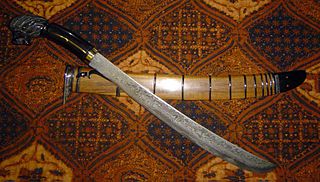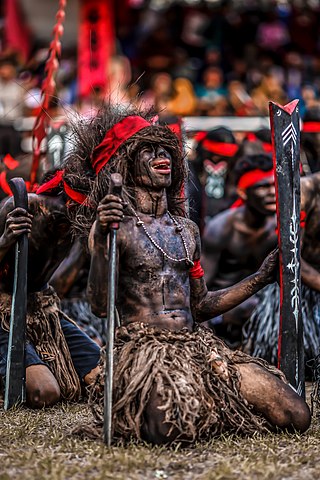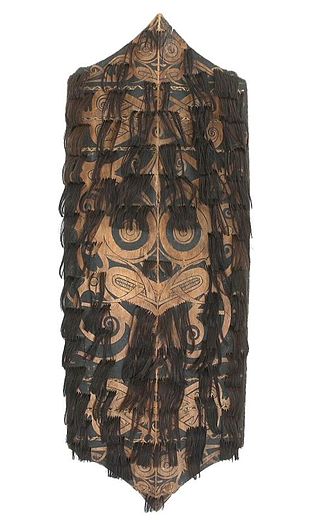
The tonfa, also spelled as tongfa or tuifa, also known as T-baton is a melee weapon with its origins in the armed component of Okinawan martial arts. It consists of a stick with a perpendicular handle attached a third of the way down the length of the stick, and is about 15–20 inches (380–510 mm) long. It was traditionally made from red or white oak, and wielded in pairs. The tonfa is believed to have originated in either China, Okinawa or Southeast Asia, where it is used in the respective fighting styles.
Hamzah Fansuri was a 16th-century Sumatran Sufi writer, and the first writer known to write mystical panentheistic ideas in the Malay language. He wrote poetry as well as prose.

The kris, or keris in the Indonesian languages, is an Indonesian asymmetrical dagger, both weapon and spiritual object, with distinctive blade-patterning achieved through alternating laminations of iron and nickelous iron (pamor). Of Javanese origin, the kris is famous for its distinctive wavy blade, although many have straight blades as well, and is one of the weapons commonly used in the pencak silat martial art, native to Indonesia.

A golok is a cutting tool, similar to a machete, that comes in many variations and is found throughout the Malay archipelago. It is used as an agricultural tool as well as a weapon. The word golok is used in Indonesia and Malaysia and in the Philippines. Both in Malaysia and in Indonesia, the term is usually interchangeable with the longer and broader parang. In the Sundanese region of West Java it is known as bedog.

Cakalele dance is a war dance from North and Central Maluku in Indonesia. Hybrid versions also exist among the natives of Sulawesi, Timor, and the Tanimbar Islands. The dance is performed by men, two of whom represent opposing captains or leaders while the others are the warriors supporting them. After an opening ritual, the captains engage in a mock-duel with a spear (sanokat) and long knife (lopu) while their supporters use a long knife in the right hand and a narrow wooden shield in the left hand. The shield is referred to as a salawaku, or by a local name such as the Tobelo o dadatoko. The cakalele originated as a way for the warriors to celebrate after a successful raid. Dancers dress in full warrior costume and are backed by the rhythm of the drum and gong (tifa) and fife (sulin).

Listed here are the weapons of pencak silat. The most common are the machete, staff, kris, sickle, spear, and kerambit. Because Southeast Asian society was traditionally based around agriculture, many of these weapons were originally farming tools.

The tekpi is a short-handled trident from Southeast Asia. Known as tekpi in Malay, it is called chabang or cabang in Indonesian, siang tépi in Hokkien, and trisul in Thai. More than a weapon, it was also important as a Hindu-Buddhist symbol. It is comparable to the Okinawan Sai.

Balato is a sword that originates from Nias, an island off the west coast of North Sumatra, Indonesia.

The badik or badek is a knife or dagger developed by the Bugis and Makassar people of southern Sulawesi, Indonesia.

Sewar refers to a dagger of Indonesian origin, typically carried in a belt and used mainly in Sumatra, Indonesia. The blade is also referred to as Sewah by the Gayo people, Seiva by the Minangkabau people, Siva by the Alas people, and Siwaih by the Acehnese people.

Palitai is the traditional knife of the Mentawai people, originating from the Mentawai Islands off West Sumatra, Indonesia.

Wedung is a traditional large knife of the Javanese people and the Balinese people originating from Indonesia.

Kurabit is a traditional shield originating from the Mentawai Islands off the coast of West Sumatra, Indonesia.

Baluse or Baloese is a traditional shield of the Nias people originating from Nias, an island off the west coast of North Sumatra, Indonesia. Baluse in the Northern Nias is somewhat smaller than those of the rest of the island.

Nias people are an ethnic group native to Nias, an island off the west coast of North Sumatra, Indonesia. In the Nias language, the Nias people are known as Ono Niha, which literally means 'descendants of human'. Nias island is known as Tanö Niha, with Tanö meaning 'land' in the Nias language.

Peurise Teumaga or Peurise Lembaga is a shield originating from Aceh, Indonesia. This shield is very identical to the Peurise Awe, except that it is made of brass instead of rattan. The shield was also used by Acehnese warriors during the Aceh War against the Dutch colonials in the 19th century.

Peurise Awe or Peurise Awi is a shield originating from Aceh, Indonesia. The shield was used by Acehnese warriors during the Aceh War against the Dutch colonials in the 19th century.

The Klebit Bok or Kelavit Bok is the traditional shield of the Kayan and the Kenyah people originating from Borneo. It is similar to the shields used by other Dayak people such as the Kliau of the Iban.

Indonesian martial arts includes a variety of fighting systems native to or developed in the archipelago of Indonesia, both the age-old traditional arts, and the more recently developed hybrid combatives. In the Indonesian language the term bela-diri is used to mean martial art, and in essence the Indonesian fighting arts are meant as one's defence against perceived threat and assault. Other than physical training, they often include spiritual aspects to cultivate inner strength, inner peace and higher psychological ends.

Pisau raut is a whittling knife that is commonly as a tool to prepare the rattan and other fine carving found throughout the entire Malay archipelago. It is well known as an accompanying knife placed in the same sheath with the mandau, a traditional weapon of the Dayak people.























